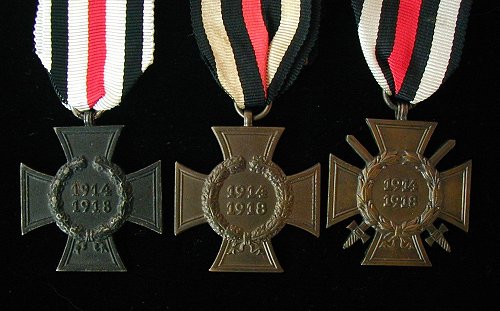
by Sebastián J. Bianchi
First of the many awards instituted by the Third Reich, the "Eurenkreuz des Weltkrieg" was established on July 13, 1934, by President Generalfeldmarshall von Hindenburg (therefore it also known as the Hindenburg Cross). The Cross, which commemorated those who served (and fell) during the Great War, was introduced as a way to reinforce pride in the veterans, and current armed forces. The only military commemorative award to be introduced during the Third Reich era, it was created by Eugene Goted, who received the commission from the Reich Chancellery.
Technical Information
All three grades of The Honor Cross had a flat reverse, with only the manufacturer's number or stamp. They also shared a common size, this being 38mm across with a raised edge line of 1mm and a recessed field.
The combatants’ grade was a bronze or bronzed iron Maltese cross with a pair of swords fitted between the arms. It featured a wreath of laurels on the center, tied at the base by a ribbon tie with the ends extending to the lower arm of the cross. The wreath was composed of five bunches of three leaves on each side, with a pair of laurel berries at each joint. In the center, the years of the Great War, "1914-1918", were placed over each other. Through the arms of the cross a pair of military swords were placed, measuring 41mm. The combatant version was awarded only to those who experienced front line combat. The upper arm of the Cross had a ribbon ring measuring 1.5mm to 2mm, through which ran a ribbon loop. The ribbon attached to it ran from 25mm to 30mm in width and featured bands of the following colors (as seen in the illustration below); black/white/black/red/black/white/black.
The non-combatant grade was very similar to the combatant grade, except that it lacked the swords a wreath of oak leaves took the place of the laurels. The same ribbon is used for this grade.
The Next of Kin grade was similar to the non-combatant grade, but the Cross was finished in black and the ribbon colors were reverse, with stripes of white/black/white/red/white/black/white. Because it was meant to be worn by the family the ribbon had a safety pin attached to it.

Starting left to right - Next of Kin, non-combatant, and combatant grades


Sebastián J. Bianchi Collection
Presentation, Wear and Documents
When presented the award was commonly in a binder with the award document on one side and the Cross on the other. They were also awarded, presumably to higher ranked recipients, in a hard hinge case found with both a black or red leatherette covering. These cases had a gold-tooled line around the edge and a hinge and catch. The inside top was lined with Satin with a facsimile signature of Generalfeldmarshall von Hindenburg and the words “TREUE UM TREUE” written in gothic script. The bottom of the inside, where the Cross rested, was covered in velvet and recessed to accommodate the award. This velvet pad, which was detachable, also had a lip on the top to allow the ribbon to run underneath it.
The Honor Cross was worn mounted as part of a group or on the ribbon bar (a small pair of swords on the ribbon differentiated the combatant version). The award ranked above service and occupation medals but below combat related awards.
Eligible for the award were all German citizens, and all German nationals who had lost that nationality due to the Versailles treaty, who had provided services to Germany during August 1914-December 1918. The combatant grade was reserved only for those members of the Imperial Army and Navy who had engaged the enemy in front line combat. The non-combatant grade was awarded to military auxiliary personnel such as administrators and Doctors, as well as civilians such as State officials and Professors. The Next of Kin grade was distributed to widows and parents of those who died or were missing in action. T he Reichsminister of interior was in charge of the distribution of the award, and all grades of the Honor Cross had to be applied for, with proper documentation presented to validate the claim.

Sebastián Bianchi Collection
As Germany expanded in the middle and late 1930’s into the Saar, Danzig, Austria, Czechoslovakia and the Memel district, orders were passed by the Reichsminister of interior to recognize those who were eligible in those areas with the time window for each being different. In May of 1942 the award was expanded to also cover those members of German and Austrian Allies who participated in the conflict, and in March of 1943 it was further expanded to include the protectorates of Bohmen and Mahren. One final addition was made in September 1944, by Hitler’s personal order, to include those members of the Deutschen Volksgruppen in the south-east.
1,200,000 non-combatant, 6,250,000 combatant and 720,000 next of kin grades were awarded.
![]()
© Copyright Wehrmacht-Awards.com LLC |